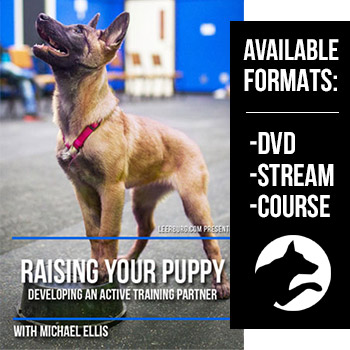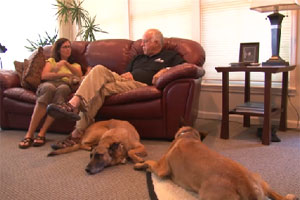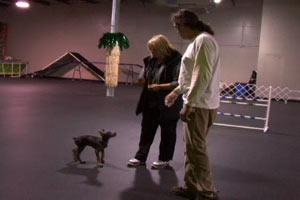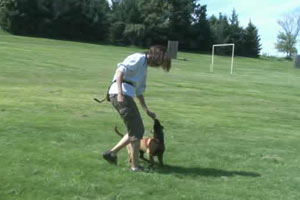How to Socialize Your New Puppy

We get many emails on a weekly basis that deal with problems new puppy owners have as a result of poor socialization. Most of these people feel they have been doing the right thing with their puppies when in fact, they have created the problems they face.
Socialization is one of the most misunderstood areas in dog training.
The old-school concept of socialization meant you take your puppy out and get it used to interacting with people, places, and other dogs. When we explain that this thinking is exactly what causes many of the behavioral problems, people ask, "How can I get my puppy socialized if I can't let him go out and play with other dogs?"
Or they will say that they thought the way to deal with a shy puppy was to take it out and let strangers give it nice treats, so the puppy saw strangers as treat machines and not something to be afraid of.
I have to admit, years ago, this was exactly how I recommended people socialize their puppies. The only problem was, over time, I learned I was wrong and there were much better ways to socialize dogs.
Our Definition of Socialization
Our definition of socialization is to get our dogs comfortable with new places and circumstances. We want our dogs to be indifferent to people, places, and things. I want my dog to look at strangers as part of the environment and something to ignore, not something to interact with.
When we take our dog into strange new environments, we want our dogs to willingly look to us for leadership and direction.
How We Socialize Our Dogs
We start socialization the minute we get our dogs. It begins by showing the dog that we control every minute of its life. This is done using leashes and dog crates. We also show the dog that we are fun to be around. This is accomplished using food treats.
As a rule, small puppies have more drive for food than for toys. With most working breeds, this will change over time if the triggers have been met at a young age. But this is food for another article.
We train with verbal markers. You can read my article titled The Power of Training Dogs with Markers.
The work with puppies begins with "charging the mark" and establishing a value for food rewards. This only takes a few days. Once we have it, we begin to work on the process of "engagement."
Engagement
The core of our program on socializing your dog deals with engagement.
When a dog is engaged with his handler, the dog is totally focused on the handler and ignores everything in the environment around him. This is a learned endeavor. Very few dogs will do this without training. If I had to put a number on it, I would say 1 in 10,000. The vast majority of dogs need to go through training steps to get and stay engaged with their handler.
We start our puppies on engagement with high-value food treats. I don't mean Walmart dog biscuits here. I mean small pieces of meat or some of the high-end all-natural dog treats we sell. When the dog is looking at us, we mark the behavior and reward it with a food treat. We also work engagement when the puppy is hungry. This means before we feed the dog. They quickly learn you're a cool owner that is fun to be around.
The process of training engagement is beyond the scope of this article. I could write a book on it. The video I produced titled The Power of Training Dogs with Food has a large chapter on engagement.
Engagement begins at home in a distraction-free environment. (i.e., your kitchen, garage, or fenced backyard). As the dog learns to become more and more engaged with the handler, trainers can begin to take the dog to new locations and working engagement in new places. In the beginning, we select distraction-free environments.
The dog will begin to learn that cool things happen when it gets taken to new locations. Gradually, we increase the level of distractions.
The goal of the trainer is to go to as many different locations as possible with their dog and work engagement drills. As the program progresses, the handler looks for locations that stress the dog. This will become evident because it will become more difficult to engage the dog. When that happens, back away from the distraction to the point where you can get and keep the dog engaged. Once that happens, you continue to go back to that location and work on shortening the distance to the distraction.
The Problem with Strangers
The problem with allowing strangers to meet and greet your dog is there are very few people who understand this work. They can't read the body language of a puppy to understand when it is stressed or fearful. This can easily result in putting a puppy into fight or flight. Once that happens, you have a big problem to fix and it's a whole lot easier to avoid a problem that to go back and try and fix one. That can sometimes take weeks and months.
Learn How to Deal with Strangers and Your Puppy
The correct way to act when around someone's new puppy is to ignore the pup. Don't invade its space; don't look at it; don't talk to it: don't try and pet it.
Your job is to find a way to tell EVERYONE that approaches you when you are walking your dog exactly that. For every one person that understands this concept, there are 100,000 that don't. I am always amazed at how many people out there ignore your warning and walk right up to your dog and try and pet it. When that happens, it is time to get real serious with people. I am far more concerned about my dog than I am about some idiot that can't think, listen, or follow directions about my dog.
Too many new dog owners are afraid to be rude to someone who invades their puppy's space. Those are the people who end up with a pup that becomes fearful of strangers. Fearful puppies often bark at people (because their pack leader failed to protect them) which results in the stranger backing off. This only teaches the pup that acting aggressively works to drive scary people away. New owners then wonder why their pup goes off on everyone he sees. Well, it's because the owner trained the pup to do this.
It is a lot easier to tell people who won't listen to BACK OFF! Don't worry about their feelings. They certainly are not someone you want as a friend if they ignore you.
What To Do When Strangers Approach your Pup
The correct way to handle strangers is to always be prepared with a bait bag full of high-value food treats. If you see that your pup is a little concerned about someone, then get the pup engaged with you. It's your job to become more interesting than the stranger and if the food rewards are high enough, the pup will look at strangers as the trigger for their owner to play with them and give them really cool treats.
The same thing goes with new places that stress your puppy. If you see the pup getting a little nervous, get him engaged with you. Teach the pup that new scary places are not that bad after all because they are places where they get to play with their owner and get cool dog treats.
Why Not Let Strangers Feed Our Puppy?
So why not let strangers give your puppy treats? A good question with a couple of answers:
- Allowing other people to give your puppy teats only turns other people into distractions for your dog. You are essentially training your dog to ignore you around other people places and things. Where is the sense in that?
- If you have a dog that is fearful of strangers, you run the risk of the dog's food drive overpowering the weak nerves. When that happens, the dog will go to the stranger, take the food, and once the food is gone, the dog is still left with his concern about the stranger. Quite often, these dogs will then bite (because aggression has taught them that strange people will back off).
- When people have a fearful dog and they allow strangers to give their puppy or dog food treats, the dog learns to expect it.
There will come a time when you don't have a food reward to give to a stranger that is going to make your dog nervous. Don't kid yourself that the dog doesn't realize this. In its head, it's thinking, "I WAS RIGHT! THIS PERSON MAKES ME NERVOUS AND HE IS NOT ONE OF THOSE PEOPLE WHO GIVES ME TREATS SO I AM GOING TO BITE HIM!"
Then the dog owner is in the position where they have a fearful aggressive dog and they wonder why. The fact is what they have done will amplify fear aggression in the dog.
What About Strange Dogs?
Let's start with the fact that it often only takes one instance where a dog is attacked by another dog for that dog to become dog aggressive for life.
New dog owners do not have the experience to recognize the signals and signs of dominance and aggression in a strange dog. For these two reasons, new puppy (or new dog) owners should NEVER allow strange dogs around their dog, NOT EVER!
Those who chose to ignore this advice need to read the article I wrote titled How to Break Up a Dog Fight without Getting Hurt. Have a look at the dog bite photos that have been sent to me from people who read the article after trying to break up a dog fight and then going to Google to find out what they did wrong.
There is nothing wrong with your dog having other dog friends, but the way to start your puppy learning manners around a friendly dog is to first find someone who thinks like you about dogs. Then look for a dog that is aloof to other dogs. I want a dog that ignores my puppy. In the beginning, the best of all worlds is to find a dog that doesn't want to play and is totally aloof to my pup. If I keep my pup on a long line, I can work some engagement around the other dog. The perfect adult dog is one that will put a puppy in its place for inappropriate behavior without actually hurting it. This has to be done before the pup is 8 to 10 months old. It goes without saying that this work is always done when the owner is there to supervise.
Putting two strange adult dogs together is never recommended unless you follow the correct protocol, and this article is not the place to talk about that.
I wrote an article on why dog parks are a bad idea. If you're a new puppy owner, you may want to visit that article. With that said, you can use a dog park to help train your dog. The way to do it is to stay outside of the fence with your dog and work engagement exercises without risk to your puppy.
What If a Strange Dog Approaches Us On a Walk?
Your job as a new dog owner is to learn how to become a pack leader. Most people are not born pack leaders but anyone can learn to be one. I have written article on this and done training DVDs on it.
Part of the responsibility of a pack leader is to protect the lower-ranking pack members. This means it's your job to protect your dog if it's approached by another strange dog. If you walk in an area where there are strange dogs, carry a stout walking stick or bear spray.
When a strange dog approaches you, step between your puppy and that dog. Sound very convincing and threaten the other dog to turn and leave. If it comes close don't hesitate to use the stick or spray. I will guarantee you that if you crack a strange dog over the head with a stout stick, it will remember exactly who you are and will never come after you or your dog again.
Not only that, but in doing this, you just gained a great deal of respect from your puppy (or dog).
Here again, I need to bring up the point that far too many people are concerned about hurting other dog owners' feelings. If you need to do this because another owner refuses to control their dog, well, so be it. There are enough idiots in the world and I don't really care what they think about the crazy guy with a big stick.
Socializing Begins at Home
A well-socialized dog starts right in your home. Teaching your new dog manners and how you expect it to live in your home sets the stage for your relationship.
We now raise our puppies in an ex-pen and a dog crate in the house. I am in the process of raising a Mal puppy at the moment. He currently is 6 months old and has lived in the ex-pen since he was 8 weeks old.
I am privileged because I get to work in my home office with my ex-pen right next to my desk. My office has ceramic tile in case of any house training mistakes. Because of this arrangement, there have been very few. When the pup is not in the pen, he is in his dog crate, but he spends most of the time in the pen.
This is where I taught him not to jump up on the sides of the pen when people come in. If he jumps up, we simply say NOPE or YUCK and step back. They quickly learn that there is no interaction when they are jumping up.
The beauty of this system is that we can take the pen into our living room where we have our adult dogs and the puppy can be part of the family without the constraints of a dog crate. It can lay in his ex-pen while the older dogs lay around as we watch TV. This is just a great way to teach a puppy not to be wild in the home.
In addition to this, we never allow our puppies to be off lead in the house. When they are out of the ex-pen they are on a lead. We use a buddy leash system (or one of our thin puppy leashes) that allows us to tether the dog to us ALL THE TIME. Allowing puppies to have free range in your home is a license for disaster. Puppies that are tethered to you can't get into the garbage, they can't sneak around the corner and pee or poop, and they can't jump up on visitors or kids. New pet owners think the leash is only for outside use but nothing can be further from the truth. Using a tether in the house is a great way to control your pup and head off problems.











Ask Cindy.